XFEL: Questions and answers with Andreas Schwarz
Questions and answers with Andreas Schwarz
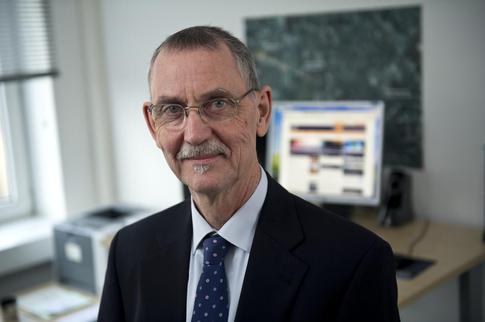
Andreas Schwarz, scientific director at European XFEL, retires at the end of September after more than 15 years working on the project. Copyright: European XFEL
For more than 15 years, European XFEL scientific director Andreas Schwarz has been instrumental in shaping the X-ray research facility. Since 2003 he has overseen the planning and construction of the site, has watched the company grow and the first users and results arrive. Before he retires at the end of September, Rosemary Wilson spoke to him about how he got involved with the project, how European XFEL came to be located in Schenefeld, and what he intends to do once he has more free time.
How did you get involved with European XFEL?
I am a particle physicist, and in the 1990s I was working as a leading scientist at DESY in Hamburg. I was fortunate and honored to be elected spokesperson for HERA-B, a large particle collision experiment that brought together over 30 institutions. Towards the end of the project in about 2003, Jochen Schneider, the initiator of the European XFEL project and then head of photon science at DESY, asked me whether I would like to get involved.
How did you go about setting up European XFEL?
The German government had just approved the funding, and so Jochen, Thomas Tschentscher, now scientific director of European XFEL, and Reinhard Brinkmann, now member of the DESY directorate and I sat together to discuss how to approach this project. What kind of governance would it need? What kind of scientific-technical work did we need to do? We ended up with a number of working groups focusing on different technical topics as well as administrative and legal aspects. As the German government had decided that XFEL should be an international project, they established a number of international committees with key international scientists to guide and inform our work.
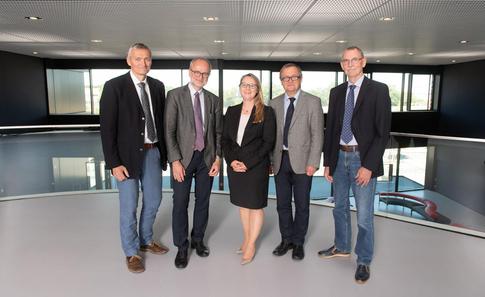
Together with the European XFEL management board in 2018. From l to r: Thomas Tschentscher, Robert Feidenhans'l, Nicole Elleuche, Serguei Molodtsov and Andreas Schwarz. Copyright European XFEL
Why is European XFEL located in Schenefeld?
One of our first jobs was actually to consider where to build it. European XFEL was originally designed to be part of a much larger project, the TESLA linear collider. Since the collider itself had not been approved in 2003, we did not have to stick to the original suggested location and were free to look for other sites. We considered various options – one of them ended at DESY for example, so that everything we see today would have been flipped around; one ended much further south. Obviously there were restraints – we needed an area without much traffic and vibrations in the area of the photon generation and transport tunnels. In the end, Schenefeld was found to be the most suitable. And the Schenefeld authorities were always very supportive.
How did you prepare the local residents for the construction?
From the beginning, the PR group did a lot of work informing landowners and residents. Together we went from door to door, being offered coffee and cookies in people’s living rooms, and answering questions. This was really essential and helped to settle unease and increase local support as the project progressed.
What did you have to do before construction could start?
Before you can begin to build anything large like a new harbor, airport or something like European XFEL, a legal framework has to be put into place. In our case, a special agreement had to be signed between the states of Schleswig-Holstein and Hamburg before we could take the next step. Then we started the so-called plan approval process.
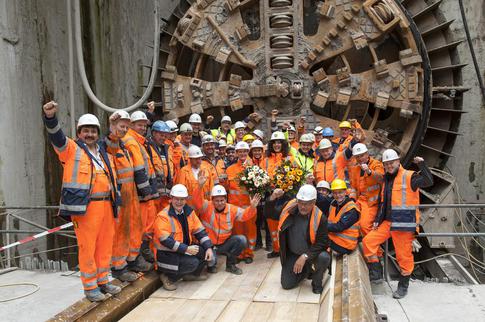
Celebrating the arrival of one of the tunnel boring machines, AMELI, 2012. Andreas Schwarz is seated front right. Copyright European XFEL
What did the plan approval process entail?
It is a huge and important undertaking that includes everything involved in the construction of the facility. You have to do an environmental study, state how you will compensate what you will have to remove, detail the buildings you will build. It is critical to think about how to minimize the impact on people’s lives and surroundings. We spent two years compiling all the information and filled ten folders detailing every aspect of the project. Local residents then had the opportunity to read them at local government offices and voice their concerns. We received about 200 complaints – from handwritten letters to detailed letters from lawyers representing interest groups. The public authority leading the plan approval process then organised an open hearing in a local hall where we explained the project and answered all of the complaints – some were accepted and others we explained why they weren’t feasible. Based on all of this, a year later the final plan was then approved and signed off by the public authority.
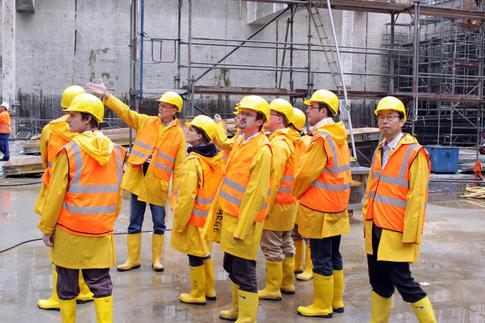
Andreas Schwarz shows guests around the European XFEL construction site in 2012. Copyright European XFEL
What was it like to finally see the diggers arrive on site?
That was a very special moment, and one of my personal highlights. It was great to see things starting to happen. As a scientist I am naturally curious and interested in new things. It was fascinating to watch and see how the engineers were building the site. As the director also responsible for the civil construction project I had privileged access to parts of the construction site that others did not! At the same time we were also beginning to restore some of the natural habitats in the area and to make decisions about the structure of the company itself, such as how many employees we should have or how would we manage it. The work didn’t stop there!
As a scientist, what was it like managing a civil construction project?
I enjoyed it! Even different scientific disciplines have their own languages but this was something completely different again covering complex subject matter. We, of course, didn’t do this all by ourselves. We worked closely together with our partner DESY as well as with an engineering office who were used to doing these types of projects. They were really helpful at guiding us through the process and even started understanding how we tick as scientists, anticipating how we might react or respond to various situations!
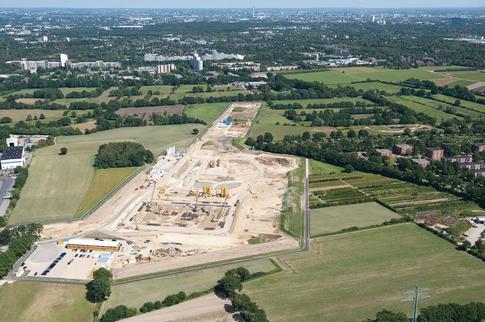
European XFEL runs 3.4 km from DESY in the distance to the campus in Schenefeld (foreground). This image was taken in 2009 as the construction began. Copyright European XFEL
You have been very involved in the project from the start. Looking back, what does this chapter of your career mean to you?
It’s been a great privilege to be involved in this project. It is really a rare opportunity and I’m lucky to have been able to follow this through from the early beginning, overseeing the construction, and being here now to see the facility operational. But even though I can tell you about the decision processes involved in almost everything here – from the colour scheme in the office building to the location of the tunnels – I don’t see it as my baby. As an example: yes, we made the final decision that the headquarter building is located exactly here for example, but this decision was based on a lot of discussion and rational thinking with many expert partners. My job was to listen to everything carefully and make sure we hadn’t overseen something. We all did this together.
What will you do once you leave at the end of September?
I want to restart playing the guitar, travel with my wife and devote more time to my family. I’m sure I’ll keep an eye on how things develop here and visit every now and again when there is a celebration, for which I hope there will be many reasons, but I plan to enjoy life as long as it lasts, and as long as it is enjoyable - even without XFEL!
